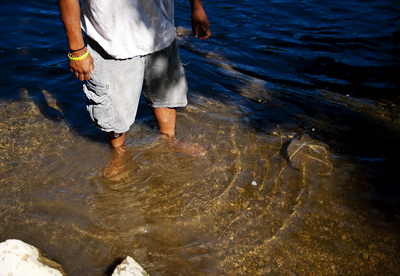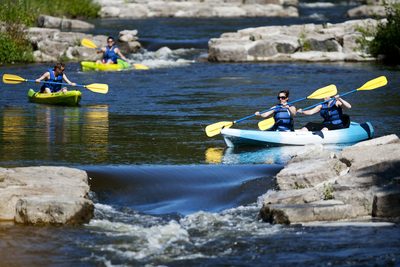Ann Arbor often finds itself on the top of many lists - and for the Huron River, it’s no different:

Ann Arbor resident Jason Talley walks in the Huron River near Nichols Arboretum on Saturday, July 13.
Daniel Brenner I AnnArbor.com
The Huron River is the cleanest river in southeast Michigan and is the most monitored river in the state, thanks to the coordinated efforts of about 500 volunteers with the Huron River Watershed Council.
Though levels of the river’s biggest pollutant - phosphorus - have significantly decreased throughout the past 15 years, the biggest hazard to human health - E. coli - continues to be an issue.
“I think (the river) is relatively healthy,” said Laura Rubin, executive director of the Huron River Watershed Council. “It’s definitely improved from where we’ve been … but the river still has a ways to go.”
The watershed
The watershed of the Huron River does not have combined sewer systems that discharge into it or combined animal feeding operations. It also contains a very small portion of farmland.
“We have more wetlands than most watersheds,” said Ric Larson, watershed planner for the HRWC. “We’ve done a good job as a community region to protect those features and we can see the results in cleaner water.”
The Clean Water Act, passed in 1972, was effective in eliminating much of the point source pollution from industrial processes and wastewater treatment plants to the Huron River. As an urban river whose landscape has been altered with dams and piped tributaries, the Huron often experiences erratic flow rates.
Phosphorus - a common nutrient found in runoff from lawns, construction and soil exposure - is the biggest polluter to the Huron River, Rubin said. Under the right conditions and at the right levels, phosphorus can lead to algal blooms that have resulted in fish kills in the past.
From 1995 to 2011, there was a 25 percent decrease in the total load of phosphorous the Huron River carries, according to data collected by the Huron River Watershed Council.
Though the state has not set a numerical standard for phosphorus levels in waterways, it has set a regional target as a whole - which Larson said they’re very close to meeting.

People kayak down cascades on the Huron River Saturday.
Daniel Brenner I AnnArbor.com
She attributes the reduction to state bans on phosphorous fertilizer use, the restoration projects on Malletts Creek at Mary Beth Doyle Park and County Farm Park, the filtration tank underneath the Pioneer High School parking lot, increased soil erosion ordinance enforcement by Washtenaw County and education and incentives by the city of Ann Arbor for rain barrels.
Drawn to the river
The river’s biggest issue concerning public health is E. coli bacteria - which is known for spiking to unsafe levels during heavy rain events. As more and more people are flocking to the Huron River for recreation, E. coli awareness becomes increasingly important.
Larson said E. coli levels in the river between Argo and Gallup are typically below the U.S. EPA’s threshold level for body contact - except in the first 48 hours after major rain events.
Genetic source tracking of the bacteria in the river has shown that the E. coli in the river comes from a broad range of animals: Dogs, feral cats and geese, as well as raccoons and other animals living in storm drains.
E. coli attributed to human sources accounts for a small component of the bacteria in the river, Larson said.
Washtenaw County Public Health monitors five public beaches at area lakes for E. coli levels - but as Huron River is technically not a public beach, the department hasn’t been asked to test it.
The health department does take reports if people get sick after being in the Huron River, and has not received any reports to date this year, said Kristen Schweighoefer, environmental health supervisor.
Sunday, July 14
Huron River Day
- Where: Gallup Park, 3000 Fuller Road, Ann Arbor
- What: A day full of events celebrating the Huron River
- When: 8:30 a.m. 5K, 11 a.m. guided canoe trip with naturalist, noon-4 p.m. activities
- More information on the HRWC and City of Ann Arbor websites
Schweighofer said although many people report norovirus-like symptoms after being in contact with the river, the health department said it’s too difficult to detect because of the volume of water in the river.
Signs are posted that recommend against swimming in untreated bodies of water, Schweighofer said.
Use of the city of Ann Arbor’s canoe liveries on the Huron set a record in 2012, as 50,336 people rented boats, said Supervisor Cheryl Saam.
“The canoe liveries were quite small when I took over 11 years ago,” Saam said. “The popularity of paddle sports continues to grow.”
Saam points to the addition of the Argo Cascades - a manufactured series of small waterfalls that can be easily navigated by kayaks or inner tubes - as the catalyst for the increased activity. Trips on the cascades doubled from 2011 to 2012.
“It’s really turned Ann Arbor to the river,” Saam said, noting she sees many people bringing their own tubes down to the Huron to travel the cascades. “It’s just opened up this whole section of the river to have this fun hangout place.”
Rubin said the future health of the river depends on an increasing understanding of connectivity to the waterway that comes from direct interaction with it.
“It’s definitely a trend we’re trying to promote. I definitely think it builds a sense of place,” Rubin said. “It’s an understanding that what comes off my rooftop or my driveway ends up in the river … That translates into land use policies; storm water policies.”
0 comments:
Post a Comment
Click to see the code!
To insert emoticon you must added at least one space before the code.